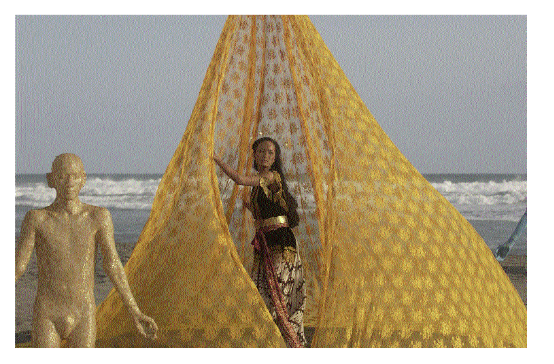At first I only had a photo of Opera Jawa, a high-res production still of a bejeweled female dancer imprisoned in a cone of billowing gold lace. Ignoring the floral-patterned glitz of the praying statue beside her, she points her fine-tuned eyebrows downward, resigned to the fate that resides just outside of the frame. Agitating my degenerate cinephilia, the uncanny beauty of the image spurred me to mount a shimmering masterpiece in my mind, the brief festival raves crystallizing my obsession with this cinematic coquette, too shy to unspool in New York City theaters.
The facts, presented to me like sacred runes, are thus: Opera Jawa is a Javanese musical directed by Garin Nugroho, and was commissioned by the New Crowned Hope Festival in honor of Mozart’s 250th birthday. When this dream-work finally hit a local screen (for a whopping one-day run), it easily trounced the feeble shadow play I had constructed in my head, tossing up a whole island’s worth of cultural history, peaking with a revolutionary war staged as puppet theater. To channel my mania I burrowed into the life and work of Mr. Nugroho. Who was this Indonesian iconoclast who had taken over the majority of my gray matter?
He was born into a middle-class family in Yogyakarta, Java, on June 6, 1961. His mother worked in the post office, his father as a publisher. In 1965, after a failed coup attempt by communist forces, the military (possibly aided by the CIA) engaged in a brutal series of retribution killings (estimated deaths range between five hundred thousand and more than 1 million), during which General Suharto was elevated to power. Garin’s father was placed under house arrest after refusing to name names to the military, but was shown leniency for his service in the war for independence against the Dutch.
Nugroho delves into this nightmare in A Poet: Unconcealed Poetry (2000), a black-and-white dirge (which ends in color) that eschews political explanations for individual traumas. It’s the most formally rigorous of the eight Nugrohos I’ve been lucky enough to see. The story unfolds entirely behind bars, where the poet Ibrahim Kadir reenacts his experiences as a prisoner through didong, an Achenese form of sung poetry that uses humor and wordplay to satirize the upper classes. The film is structured around Kadir singing these pieces solo against a black screen, bursts of mournful performance that act as counterpoint to the rest of the film, where haunted prisoners mark time until their name is called for execution. Shot in grainy DV over six days, the film never leaves the cell block, ranging nimbly to capture the untrained actors (many...
You have reached your article limit
Sign up for a digital subscription and continue reading all new issues, plus our entire archives, for just $1.50/month.
Already a subscriber? Sign in





